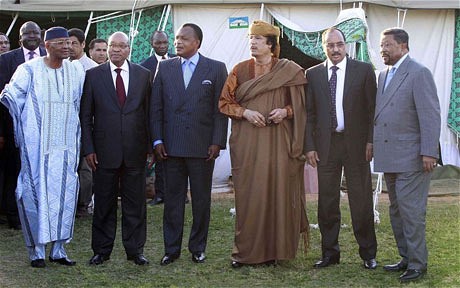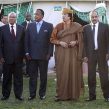
Missiles, Money and Migration: The Impact of the Libyan Crisis on the African Sahel
Publication: Terrorism Monitor Volume: 9 Issue: 15
By:

Unlike many other parts of the world, Libyan leader Mu’ammar Qaddafi enjoys widespread support in Africa as a result of years of Libyan diplomatic and economic engagement in the continent. Libyan money and arms have boosted the stability of many African regimes.
Clearly, Qaddafi’s moves in Africa were connected to the advancement of specific geopolitical and diplomatic interests. With its proximity to Libya, the African Sahel region has always been an important target of Qaddafi’s ambitious foreign policy.
Libyan support has been strong in the Sahelian nation of Mali. In the Malian capital of Bamako, the Front for Rejection of the Colonial War in Libya organized a march to the Libyan Embassy on March 19. A second rally was held on March 25, organized by the Malian Coalition to Support the Great Libyan Jamahiriya. Both protests were characterized by harsh anti-French and anti-American slogans (Journal du Mali, March 25; Mali Web, March, 29). These marches are only two examples of a more general feeling spreading throughout Africa after NATO’s attacks on Libya began. Mu’ammar Qaddafi enjoys strong popularity among the peoples of the continent and also among many of its governments. Paradoxically – given the peculiar history of Libyan foreign policy under Qaddafi – the “Brother Leader” has represented an element of stability for many African governments due to his money and his political and diplomatic support, and the possibility that his regime in Libya will come to an end is perceived as a major threat by many African actors.
Libya is one of the largest financial contributors to the African Union and it also pays many bills for small and poor countries, which explains the very cool reaction of the African Union to international efforts against Qaddafi. Through the Libya Arab Africa Investment Company (LAAICO), Qaddafi has invested in a wide range of African economic activities, including hotels, banks, telecommunications, media, agriculture and many other sectors. [1] Qaddafi’s active economic foreign policy in Africa, linked to his anti-imperialist stance and his more recent Pan-African narrative, has given him not only the support of the elites of these countries, but also the support of many intellectuals and other sectors of the population (La Depeche, March 18). This peculiar Libyan “soft power” approach to Africa has helped Qaddafi become very popular in many parts of the continent.
The Roots of Libyan Involvement in Africa and Its “Near Abroad”
Africa emerged as a priority in Gaddafi’s foreign policy once his attempts to play a major role in the Arab world failed. The African states were more receptive than the Arabs toward Qaddafi’s tools of foreign policy, specifically its enormous economic resources. The “king of kings,” as he wanted to be defined by Africans, has since the late 1990s pursued a very active political agenda in Africa. As he had already tried in the Arab world, Qaddafi was an energetic supporter of “unity” among Africans. Neighboring Chad, especially, has always represented a geopolitical priority for Libya in general and Qaddafi in particular for a variety of reasons: the territorial dispute over the Aouzou strip and the anti-Qaddafi plot – the so-called “Black Prince” conspiracy organized from Chad in 1970 – are likely the most notable.
Libya occupied northern Chad in the early 1980s and a few years later it suffered a military humiliation from the regime of President Hissène Habré (1982-1990). The relationship with Chad improved only when Déby overthrew Habré. Since then, Libya has become one of Chad’s most important economic and diplomatic supporters. Qaddafi also played a very important role in Mali and Niger; their economies have been largely supported by Libyan money and Qaddafi has played a fundamental role in brokering the peace agreements between the Malian and Nigerien governments and the Tuareg rebels signed in the Libyan oasis city of Sabha in October 2009 (Reuters Africa, Oct 7, 2009; The Tripoli Post, Oct 10, 2009). This wide net of relations in the Libyan “near abroad” explains why these governments were very reluctant to condemn domestic repression in Libya earlier or to support the international intervention later.
The War in Libya and Its Possible Impact on Sahelian Security
As mentioned before, the economic and political role of Qaddafi’s Libya role in Africa has paradoxically represented an element of stability for many governments of the region. In many capitals of the continent there is now a major fear that a prolonged conflict in Libya, as well as a weakening of Qaddafi or his complete fall, could strongly jeopardize their security. There are major concerns related to terrorism, the role of Tuareg rebels and the economic impact of this war.
The first major concern is represented by weapons that could be acquired now on the Libyan market in the absence of any consistent and effective control on its territory and its deposits. Chadian President Idriss Déby has affirmed that al-Qaeda in the Islamic Maghreb (AQIM) acquired several types of weapons from the rebels’ strongholds and warned of the risks of destabilizing Libya, suggesting, with some hyperbole, that the group is “turning into the most powerful army of the region” (Jeune Afrique, March 25). A few days later an Algerian security official told Reuters that AQIM had smuggled a huge amount of weapons acquired in Libya to Mali. The loads allegedly included Kalashnikov heavy machine guns, Kalashnikov rifles, Russian-made RPG-7 anti-tank rocket-propelled grenades and, most importantly, Russian-made shoulder-fired Strela surface-to-air missiles, known by the NATO designation SAM-7 (Reuters Africa, April 4). The day after, Algerian political officials also expressed their concerns for the situation in Libya. Abdelkader Messahel, the Algerian deputy foreign minister, told Reuters that he was worried by “the increasingly noticeable presence of AQIM in Libya” (without elaborating) and the increasing circulation of weapons which can be used by terrorists (Reuters Africa, April 5).
The main concern related to the acquisition of these weapons is that they could be used to replicate in the Mediterranean region an attack similar to that which occurred in Kenya in November 2002, when two SAM-7 missiles were fired at an Israeli passenger jet taking off from Mombasa International Airport. However, even if these allegations were all true, the potential impact of these weapons must be carefully addressed. Most worrisome are the mobile (truck-mounted or man-portable) optically-guided or infrared-guided missiles believed to be in Libyan hands. Russia’s Kolomna Machine-Building Design Bureau (KBM) has admitted selling truck-mounted SA-24 “Grinch” missiles after they were spotted in press photos by Aviation Week [2] This modern and highly effective weapon would be in great demand for terrorist operations if it could be made man-portable, but KBM insists this cannot be done without a separate trigger mechanism, one that was not supplied to Libya (Aviation Week, March 29).
It is more likely that these allegedly stolen missiles are the earlier and more basic Soviet-made man-portable SA-7 “Grail” missiles, which were purchased in large quantities by Libya. [3] Though these weapons pose a potential threat to passenger planes in the hands of AQIM, they are more likely to be used for defensive rather than offensive purposes, firing at military helicopters or surveillance planes. However, Africa has a rich and dynamic black market for weapons, which means AQIM could have access to rockets and missiles not only in Libya, but also in other parts of the continent. It is likely, therefore, that both Chad and Algeria want to emphasize this threat in order to advance specific foreign policy interests related to the on-going conflict in Libya. Using the name of al-Qaeda is always a powerful tool to get the attention of Western powers, above all the United States, in trying to make them more receptive to some specific interests of the countries of the area.
Another threat for the stability of the countries of the Sahel could be posed by Tuareg rebels from Mali and Niger who have been employed as mercenaries among Qaddafi’s supporters in the past few weeks. In this case, the risk could be presented by the return of these fighters to their own countries, armed with weapons grabbed in Libya (Ennahar, March 28). As mentioned earlier, Qaddafi has played a major role in settling many of these domestic conflicts. An end to Qaddafi’s regime in Libya also means the end of the presence of a powerful protector for the Tuareg in these countries. The mix of armed Tuareg and the absence of the most powerful diplomatic broker in the region could represent a serious threat for countries in which Tuareg rebels are present in significant numbers.
A further crucial point for the security of the entire area is the linkage between economy and security. Qaddafi’s Libya represents one of the backbones of the Sahelian economy. The countries of this region are very poor and the money that Qaddafi pours into these economies every year is fundamental to their existence. The end of Qaddafi’s regime will likely mean the end of the financial flows from Libya to these countries. Given the highly personalized foreign policy of the Jamahiriya and the level of domestic political tension within Libya nowadays, it is likely that a new power elite in Libya will pursue a foreign policy agenda completely opposed to that of Qaddafi. The African option is one among others and not the only one that a new Libyan government could pursue. Even with Qaddafi, the African option became a top priority in Libyan foreign policy agenda only after the failure of attempts to win a major role in the Arab world. The end of Qaddafi’s Libya could also mean the return of many Sahelian workers to their own countries; Chadian immigrants alone in Libya number 800,000 (al-Wihda, April 4). The collapse of Qaddafi’s regime would ensure enormous economic and demographic pressures on governments whose resources are very limited. This potential crisis should also be analyzed in the wider context of other on-going African crises; the violent clashes in Ivory Coast are only the latest reminders of the potential for instability in Africa. In the next few months, other major African countries, such as Nigeria, will have elections whose outcomes could be contested, sparking other internal conflicts. That could mean a further increase of migration pressures on other countries, economic troubles, the eruption of violence and the risk of spill-over conflicts in other parts of the continent where ethnic and confessional balances are very fragile.
Conclusion
Mu’ammar Qaddafi’s African largesse and popular regional sympathy for the Colonel explain why the governments of the Sahel nations have been reluctant in supporting the international intervention against him. This behavior is not only linked to a sort of “political benevolence”: it is also linked to an analysis based strictly on interests, recognizing that Qaddafi in power better serves the security, political and economic interests of these countries than the unpredictable course of revolution.
Geographically, Libya will always have an interest in the Sahel, but politically the emphasis could be different and far less effective and consistent under a new regime than in the past. These governments fear the loss of funds that are needed to support their weak economies and give these regimes resources to share in order to boost their own power. They also fear the presence of AQIM and armed Tuareg rebels returning from Libya. The collapse of Libya would have an immediate impact on the structurally weak Sahel region with long-term implications for security and development.
Notes:
1. A complete map of Libyan economic involvement in Africa is available at: https://www.laaico.com/invest.htm.
2. The Russian name for this weapon is Igla-S 9K338.
3. The Russian name for this weapon is 9K32M Strela-2.





